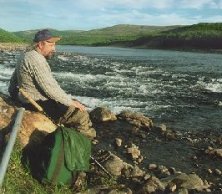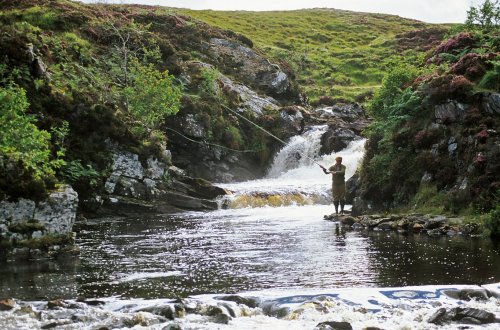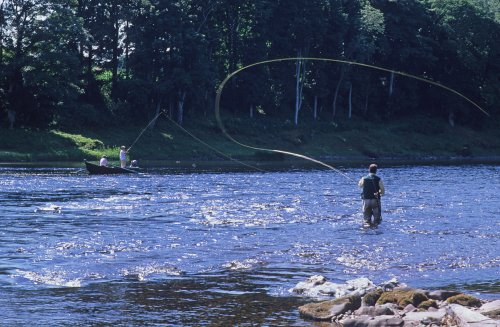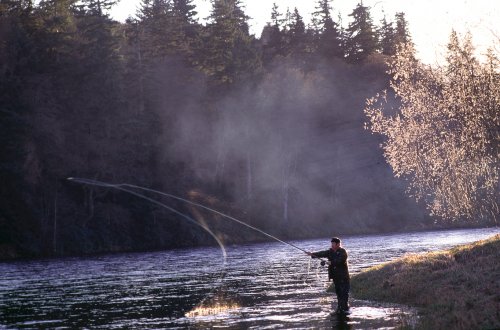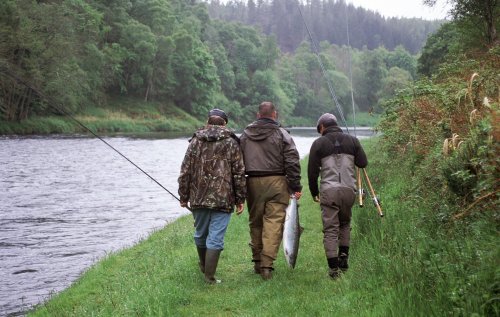An article for all fishermen who would like to start to fish for Atlantic Salmon.
Spring is around the corner, and I often get questions from fly fishers who are planning to go to Scandinavia for salmon. Since many of them have never fished for salmon before, here are a few reminders on what a fisherman should think about and what he/she should have before starting off to fish for salmon. I have fished for salmon for over 30 years, but I'm not and never will be an expert - though I can at least manage some of the basics!
In the first place, the prospective salmon fisher should reflect once again on what they are getting into. Salmon fishing isn't cheap, catches can be few and far between, the environments are often harsh, and in spite of this it is easy to become addicted to it! Many salmon fishers don't even have a family, since there is no time or money for it. Salmon meat is excellent and healthy, but those whose main aim is to catch for meat, I recommend buying fish in the supermarket and forgot about fishing for it. They will surely save money that way.
So what does the salmon fisher definitely need to get started? I'll begin with clothing. Because I started off in small rivers of northern Norway, I thought that hip waders were sufficient. After the first year, however, I got sick of walking around with my waders full of water, and realized that chest waders are a necessity. I prefer the breathable type. I'd rather use a few layers of thermal underwear at the beginning of the season than sweat in the summer in neoprene. Next, a short wading jacket with a few pockets, and something for your head - a cap or hat depending on your preference. But most fly fishers already have these things. Another important thing is a relatively large backpack of around 30 liters volume. You won't be just taking food with you, but also an ever-growing amount of fly boxes and various other not-completely-necessary items. Some fishermen like those backpacks that can double as a seat. That's not a bad idea, though of course there are heavier. If your chosen river is a smaller stream with gravel shores, then a wading staff might not be necessary, but in larger currents it can be a good helper. I like using a telescopic aluminum model such as those for walking.
And now, what are we going to catch those salmon with? I'll begin with the rod. In the beginning, one might be sufficient, but if you stick with this sport then count on your number of rods growing - thankfully not exponentially. Fishing with a one-handed rod is certainly possible. If you focus on smaller rivers that can be more easily waded, and plan on fishing during summer, then that's probably all you'll need. An approximately AFTMA 7-8 rod is fine. For larger rivers, rivers that are difficult to wade, and higher or colder water conditions, heavier flies are needed. Heavier flies are more easily cast with heavier line or with sinking line, and a two-handed rod is a plus. I prefer a two-handed rod, and take my one-handed only a few times a year. I believe I have better feeling and control with the two-hander, and line mending is easier. No rod is universal, but a 14' AFTMA 9-10 should suffice at first. If your river is smaller, you can go down in both rod length and line weight (13' AFTMA 8-9). For bigger rivers, go the opposite direction to a 15' AFTMA 10-11. Rod action is a personal preference, but don't buy a rod with a heavy tip, as you will regret it later. I like to use quicker action rods. When using a long-headed line, such as Spey lines, they will slow the action down sufficiently. But a slower action rod can never be sped up. It's difficult to suggest anything about price, since even inexpensive rods these days are good, and for the most expensive you are of course partly paying for the name. But at least your fellow fly fishers will be jealous!
The next important thing is the reel. Buying a reel with a complicated automatic brake seems unnecessary, especially since the more complications there are, the more there is to break down. A simple robust reel will be reliable, and should be able to take 100m of 35 lbs. backing, or even 200m for larger rivers. It's good when you can brake the spool can by hand - as you'll see with the first big fish, your hand is the best brake. I'm a bit conservative, and the modern large arbor reels suit me. I've got a Pflueger Medalist and a System2, and so far I haven't needed anything else. Of course when I see a Bogdan, Noel, Balian or Sarracione my heart beats faster, but I haven't been able to bring myself to buy one of those treasures.
Another necessary part of your equipment is the fly line. To start with, I recommend a line with a changeable tip (multi-tip). Most come with four types of tips - floating, intermediate, sinking, and fast sinking - which is good enough for almost 100% of my fishing needs. Only in extreme conditions in spring do I fish with a fast shooting head sinking line. The length of the line is more complicated. For the so-called Scandinavian underhand cast, a short head of 8-13 m and shooting lines are used. For classical casting the Spey type of lines are used, with the head about 18m up. Most fishermen learn to cast a shorter head first, but the effectiveness of a long head can't be beat.
The next part is the leader. Today, there are two main types - classic nylon and fluorocarbon. I use both. When fishing with fast sinking line in spring, I use nylon, because fluorocarbon is a fast sinker itself, and there would be too much of the leader on the bottom. In all other cases, I use fluorocarbon - not because I believe in the pseudoscientific myths about invisibility, but for two other reasons. First, as I mentioned, fluorocarbon sinks, so there's less chance that the flies will plow along the surface. Even the smallest summer flies sink 10-15 cm below the surface. The second reason is that fluorocarbon is harder than nylon, and the leader straightens out better. For spring fishing with a fast sinking line, a 1.5 m 0.4-0.45 mm non-tapered leader is sufficient. For normal conditions, use a tapered 2.7-3m of about 0.35mm, while in low summer waters with small flies use 3.5m of 0.5-0.3mm.
Now of course the one part of your equipment that the salmon are going to appreciate is the flies. Don't let yourself get scared away by all the patterns you see in the catalogues - there are thousands. I guarantee you won't need them all - in fact, A.H. Wood, one of the biggest icons among salmon fishers, uses just two patterns and still thinks that's too many! I've settled on 4 types, but my opinion is that it's most important to have various sizes. The basic rule is - bad lighting, dark fly; sunny weather, light fly - with the caveat that in sherry-colored water a little orange or red is good. The most important color is probably black. Hugh Falkus said that a good salmon fly can be any color, as long as it is black. I guess the most well-known black pattern is the Munroe Killer, with Black Bear, Black Doctor, and Black Dose up there also. Because my home river is sherry-colored, at the beginning of the season I use red-orange flies, Allys Shrimp being my favorite. For lighter flies, I use Green Highlander as well as Silver Grey. And last but not least, the universal Thunder & Lightening. So - Munroe Killer, Ally Shrimp, Green Highlander and Thunder & Lightening and I'm ready to go. One hook, two hooks, three hooks, or tube hook, it all depends on your preference and what the local regulations on the river are. Here, the rule is - colder water, larger flies, lower water and warmer water, smaller flies. So for spring, 1/0 single hook/2 double hook/4 triple hook and tube hook about 5cm; for normal conditions 4/6/8 and 3.5 cm tube hook; and for summer 8/10/12 and 2.5 cm tube hook. This is just a starting point, however; the river you are fishing also determines the size of flies. For instance, on some rivers such as the Alta and Reisa in Norway larger flies are used, while in Ireland smaller are preferred.
And now we come to some kind of equipment to deal with caught fish. Luckily, gaff hooks have almost disappeared. On most rivers there is a bag limit and gaffs are prohibited. A tailer is a loop that can be lassoed around the tail of a played-out fish, allowing it to be caught without injury. In theory this looks easy, but in practice it is pretty difficult to learn. I've seen cases where fish have pulled the tailer out of the fisherman's hands and run off with it. Other experts have managed to get both the salmon and one of their fingers in the loop. There are also special landing nets that can be carried on your back and be opened with one hand. They are good if you have the manual with you or fish where there's nothing growing on the bank. But taking this kind of net through the forest or brush can wear down even the toughest nerves. So the last option is handtailing, in which you hold the tail of a played-out fish and gently lift it from the water. You can handle up to a 12-13kg fish this way, and can even practice at home.
Last but not least, there remains the river and the fish in it. I'm not going to write about all the places that salmon exist, or give advice on individual rivers. Extensive statistics and fishing conditions are easily available on the Internet. On rivers with private fishing privileges, it's simple - you buy a permit for a certain time and certain stretch. The stretches can vary in length, from a few hundred meters up to many kilometers. For most national and club waters there are also zones, but they are generally fished daily. And not all stretches are suitable for fly fishing. There are also differences in the size of fish - one river may have mostly large salmon, while another mostly small. I think that in the beginning it's better to start on a good river but with lower average weight. This is simply because on a river where 5 tons of fish are caught averaging 2kg, there will be more action than on a river giving 5 tons of 7kg fish. It's always better to catch smaller fish than no fish! Count on a day of fishing costing from 25 euros up, and the cost doesn't just depend on how many fish the river holds but also on the services available. On some rivers you can find hotels with restaurants, guides, and even opportunities to fish from rowboats. On others, it's self-catering in the camp. Each country has cheaper and pricier rivers, and even on one river there can be different priced stretches. The price wars are currently being led by Iceland and Russia, while Ireland and Sweden are at the other end of the spectrum.







